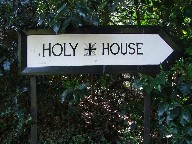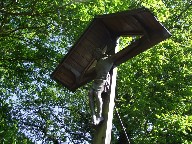| |
|
All
Hallows Convent Chapel, Ditchingham
 |
|
Ditchingham
was that rare thing in 19th Century East Anglia,
an Anglo-Catholic hotspot. The parish sits in the
Waveney Valley on the Suffolk border, and,
perhaps mindful of their puritan credentials,
rural people in the east of England were highly
suspicious of the new ritualist ideas emanating
from Oxford in the 1830s and 1840s. Enthusiasm
for Anglo-Catholicism in East Anglia was limited:
a few churches in Norwich, the antics of George
Drury at Claydon and Akenham in Suffolk, and that
was about it. Walsingham was still nearly a
century away from taking part in the Great
Revival of sacramentalism. But here,
on the outskirts of Bungay, two families caught a
burning brand from the wildfire beginning to
spread through the Anglican church. They were the
Sucklings of Barsham and the Crosses of
Shipmeadow, two adjacent parishes on the Suffolk
side of the border. With the help of their not
inconsiderable resources, the Bungay area became
East Anglia's main centre of Anglo-Catholicism.
|
One of the
features of Anglo-Catholicism which the stout-hearted
protestant peasants of Norfolk and Suffolk found hardest
to stomach was the establishing of religious communities.
These groups of Anglican men and women set apart and
living consecrated lives were frowned upon not only by
the press of the day, but by the Diocese of Norwich
itself. In fact, religious communities were, by the
1850s, a familiar feature of the English landscape - but
they were Catholic, of course, not Anglican. They had
usually been established by groups fleeing France during
the terror of the Revolution half a century earlier. The
Catholic Sisters and Brothers were generally received
with sympathy, since the people of England warmed to
revolution even less than they did to Catholicism.
But
Anglican religious communities were considered a step too
far. When Father George Drury established a convent at
Claydon on the outskirts of Ipswich, he was accused by
the Ipswich newspapers of keeping a harem, an outrageous
slur in mid-Victorian England. Similarly, when the
Suckling and Crosse families helped establish an Anglican
Community of the Sisters of Mercy at Shipmeadow in the
1850s, there was outrage. However, the community
benefited from the sheltering support of the two main
local landed families, something poor George Drury never
had. Indeed, the founder of the community was one of the
Crosse daughters, Lavinia Crosse, and in 1858 the
community began to establish itself in the adjacent
parish of Ditchingham, on the Norfolk side of the border.
They called themselves the Community of All Hallows, and
their first achievement was to open a home for fallen
women, which usually meant young girls who'd had babies
outside of marriage. This building, and the convent which
began to grow around it, were the work of Henry Woodyer.
An
orphanage followed, and by 1883 Kelly's Directory for
Norfolk could note that the
House of Mercy, opened in 1859, in conjunction with the
Church Penitentiary Association, is under the care of the
sisterhood of All Hallows, and has for its object the
reception of women of unchaste lives, from all parts of
England; the house is a large cruciform building with a
beautiful chapel in the head of the cross; it can receive
30 penitents; warden, Rev. E. P. Williams; treasurer,
Sister Catherine Rotch; Miss Lavinia Cross, lady
superior. All Hallows Home, founded in 1867, is an
orphanage for girls of the better classes who have fallen
into reduced circumstances; they are admitted at any age
above 3 and under 10, with the understanding that they
remain in the Home until after confirmation; the house
will hold 30 orphans; respectable girls of the lower
classes are also received into the Home for industrial
training as domestic servants. All Hallows Country
Hospital is capable of holding 20 patients, who may be
admitted without restriction from any practicable
distance, at a small weekly payment; incurables,
convalescents and lady patients are also received at an
increased charge. These institutions are under the care
of the same Sisters.
In later years the sisters would
open a large school, the buildings of which are to the
east. They now form the Belsey Bridge Conference Centre,
managed by an Anglican Trust. The modern chapel there
houses Alan Oldfield's fabulous mural Revelations of
Divine Love. However, the work they are best known
for today is managing the All Hallows hospital down in
Bungay itself. Here, we are barely two miles from the
bustle of that pretty little town, but there is a feeling
of great remoteness about the Convent and its chapel. The
chapel, of 1865, is a grand gothic statement something in
the French style, with a bell turret and a projecting
apse.
| In
the 1950s, JP Chaplin added a rotunda with a
conical roof at the west end which appears to be
in the style of a baptistery or chapter house,
but which I think was intended as an entrance
porch. Above the doorway is a relief of the
Waters of Life pouring out into what might have
been a traditional doom scene, representing the
power of salvation. Inside, the furnishings are
much more traditional, dating back to the late
19th Century. Behind an ornate gothic reredos,
there is a narrow lancet at the east end, the
glass depicting Christ in Majesty. The chapel
is set in delightful, secretive grounds, the low
folding hills of the Waveney Valley enclosing
woodlands and fields about. The convent buildings
are to the north and west of the chapel, and this
is still one of the largest religious houses in
the Anglican communion. The vegetable gardens to
the east are bordered by a high hedge, and beyond
it is the moving sight of the sisters' graveyard,
a beautiful spot just to stand and ponder for a
while.
|
|
 |
|
|
|
